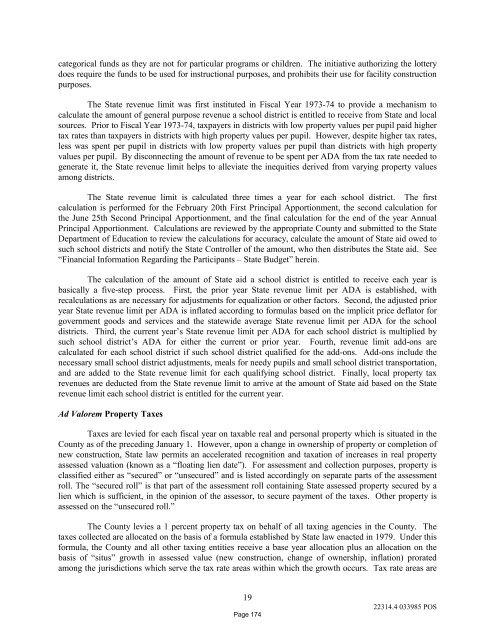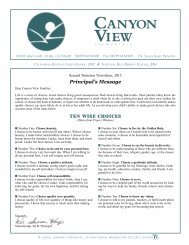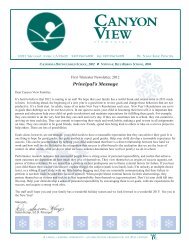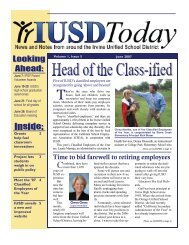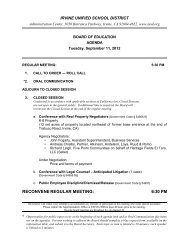reconvene regular meeting: 7:00 pm - Irvine Unified School District
reconvene regular meeting: 7:00 pm - Irvine Unified School District
reconvene regular meeting: 7:00 pm - Irvine Unified School District
You also want an ePaper? Increase the reach of your titles
YUMPU automatically turns print PDFs into web optimized ePapers that Google loves.
categorical funds as they are not for particular programs or children. The initiative authorizing the lottery<br />
does require the funds to be used for instructional purposes, and prohibits their use for facility construction<br />
purposes.<br />
The State revenue limit was first instituted in Fiscal Year 1973-74 to provide a mechanism to<br />
calculate the amount of general purpose revenue a school district is entitled to receive from State and local<br />
sources. Prior to Fiscal Year 1973-74, taxpayers in districts with low property values per pupil paid higher<br />
tax rates than taxpayers in districts with high property values per pupil. However, despite higher tax rates,<br />
less was spent per pupil in districts with low property values per pupil than districts with high property<br />
values per pupil. By disconnecting the amount of revenue to be spent per ADA from the tax rate needed to<br />
generate it, the State revenue limit helps to alleviate the inequities derived from varying property values<br />
among districts.<br />
The State revenue limit is calculated three times a year for each school district. The first<br />
calculation is performed for the February 20th First Principal Apportionment, the second calculation for<br />
the June 25th Second Principal Apportionment, and the final calculation for the end of the year Annual<br />
Principal Apportionment. Calculations are reviewed by the appropriate County and submitted to the State<br />
Department of Education to review the calculations for accuracy, calculate the amount of State aid owed to<br />
such school districts and notify the State Controller of the amount, who then distributes the State aid. See<br />
“Financial Information Regarding the Participants – State Budget” herein.<br />
The calculation of the amount of State aid a school district is entitled to receive each year is<br />
basically a five-step process. First, the prior year State revenue limit per ADA is established, with<br />
recalculations as are necessary for adjustments for equalization or other factors. Second, the adjusted prior<br />
year State revenue limit per ADA is inflated according to formulas based on the implicit price deflator for<br />
government goods and services and the statewide average State revenue limit per ADA for the school<br />
districts. Third, the current year’s State revenue limit per ADA for each school district is multiplied by<br />
such school district’s ADA for either the current or prior year. Fourth, revenue limit add-ons are<br />
calculated for each school district if such school district qualified for the add-ons. Add-ons include the<br />
necessary small school district adjustments, meals for needy pupils and small school district transportation,<br />
and are added to the State revenue limit for each qualifying school district. Finally, local property tax<br />
revenues are deducted from the State revenue limit to arrive at the amount of State aid based on the State<br />
revenue limit each school district is entitled for the current year.<br />
Ad Valorem Property Taxes<br />
Taxes are levied for each fiscal year on taxable real and personal property which is situated in the<br />
County as of the preceding January 1. However, upon a change in ownership of property or completion of<br />
new construction, State law permits an accelerated recognition and taxation of increases in real property<br />
assessed valuation (known as a “floating lien date”). For assessment and collection purposes, property is<br />
classified either as “secured” or “unsecured” and is listed accordingly on separate parts of the assessment<br />
roll. The “secured roll” is that part of the assessment roll containing State assessed property secured by a<br />
lien which is sufficient, in the opinion of the assessor, to secure payment of the taxes. Other property is<br />
assessed on the “unsecured roll.”<br />
The County levies a 1 percent property tax on behalf of all taxing agencies in the County. The<br />
taxes collected are allocated on the basis of a formula established by State law enacted in 1979. Under this<br />
formula, the County and all other taxing entities receive a base year allocation plus an allocation on the<br />
basis of “situs” growth in assessed value (new construction, change of ownership, inflation) prorated<br />
among the jurisdictions which serve the tax rate areas within which the growth occurs. Tax rate areas are<br />
19<br />
Page 174<br />
22314.4 033985 POS


